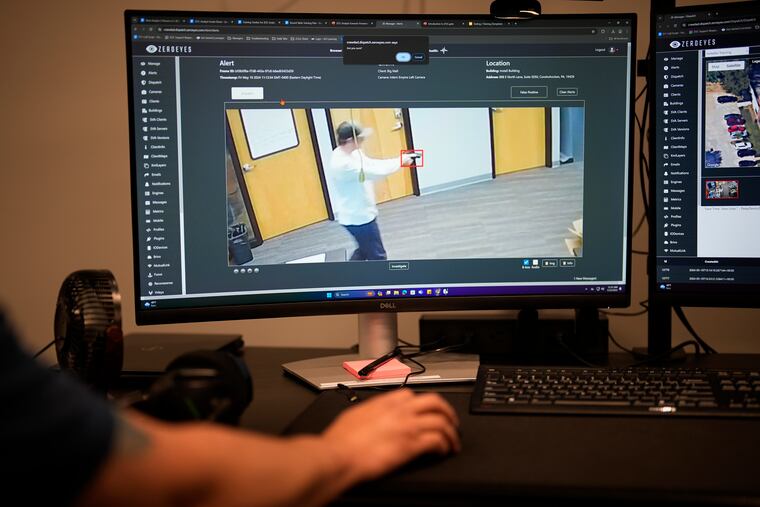ZeroEyes raises $53 million, employs over 150 as demand for gun scans grows
The firm has developed a “proactive, human-verified artificial intelligence (assisted) gun detection and intelligent situational awareness platform” to mitigate mass shootings, gun-related violence.

At a 24-hour computer center in Conshohocken, technicians for ZeroEyes monitor software tied to surveillance cameras in 42 states, checking automated reports of possible guns where they aren’t supposed to be, and other security threats to crowds of commuters, students, and other groups.
The seven-year-old company, whose five founders include four who met while serving in the U.S. Navy’s SEAL special forces teams, has built a system that uses what ZeroEyes calls a “proactive, human-verified artificial intelligence (assisted) gun detection and intelligent situational awareness platform” to help clients “mitigate mass shootings and gun-related violence.”
“We have picked up over 1,000 incidents,” and passed them quickly to clients and law enforcement, leading to “a few dozen arrests,” said Rob Huberty, the company’s chief operating officer and cofounder. There were people prohibited from carrying, people in locations where guns are off limits, and others where a gun may have been legally transported, for example by law enforcement. None involved plans for a mass shooting, fortunately, he said.
The company has raised more than $100 million in equity and debt from private investment firms, and hired more than 150 people, some of them veterans, half in the Philadelphia area. ZeroEyes is expanding its marketing efforts beyond school districts to transit systems, hospitals, and state and local governments.
The company announced this week that those investments now include $53 million collected in ZeroEyes’ newly-completed second round of venture capital funding. Those investors are led by Utah- and Silicon Valley-based Sorenson & Co. ZeroEyes investors also include computer chip giant Intel’s venture capital arm, Los Angeles-based BroadLight Ventures, Octave Ventures, and Alpha Intelligence Capital.
ZeroEyes’ first client was the Rancocas Valley School District in central Burlington County, which hired the company in 2018, the year of the Parkland, Fla., school shootings that left 14 students and three staffers dead and 17-wounded.
“We were going through a lot of plans to increase safety and security” at that time, Rancocas superintendent Christopher Heilig said in an interview three years into the program. “We had a pretty elaborate camera system,” which ZeroEyes software fit readily. The school board agreed to add ZeroEyes, with guidance from police in nearby Mount Holly: “They were all in for any layer of security that we could put in place to keep the kids and the staff safe.”
Helig added, “It’s not a metal detector.” Intrusive entry detecting machines can cross what he called “the fine line between the nurturing school system and hard security.” Rather, ZeroEyes “detects the shape of a weapon,” as distinct from a sports racket or stick. “Calls came in to our cell phones, mostly after hours,” within seconds of the system detecting a likely gun, for example during after-school-hours testing. He said there had been no “false positives.”
Rancocas Valley remains a favorite testing site, Huberty said.
SEPTA earlier this year pronounced ZeroEyes a “very good technology,” after a yearlong trial testing, amid cautions from advocates who worried any surveillance technology could be abused to racially profile passengers, and lead to false accusations.
SEPTA declined to extend the contract, noting its own network of old analog cameras could not use ZeroEyes software, according to the agency.
Last month, ZeroEyes said the Regional Transportation Commission of Southern Nevada (RTC), which carried commuters and tourists on 50 million rides around Las Vegas last year, had agreed to deploy ZeroEyes’ system for the next year. “This marks the first time that a US transit agency has deployed wide-scale video analytics for weapons detection,” ZeroEyes said in a statement marking the event. The cost of that agreement was not immediately disclosed.
The governors of Missouri and Kansas vetoed legislation earlier this year that would have appropriated several million dollars to install ZeroEyes in those states, citing concerns the legislation would have favored the company as a single-source provider over competing vendors. Huberty said the legislation ZeroEyes supported would have required, for example, that image reviewers hold federal and industry certifications, as ZeroEyes staff does. The company relies on another Philadelphia firm, Layer 8, to ensure its own work complies with applicable standards.
Other ZeroEyes users include private schools such as Germantown Academy, Appoquinimink public schools in Delaware, Great Egg Harbor Regional schools at the Jersey Shore, the UMC Health hospital network in Texas, and the Michigan State Capitol.
Besides the operations center at its Conshohocken headquarters, ZeroEyes operates a second center in Hawaii.